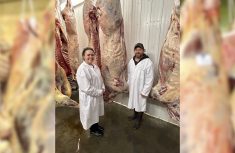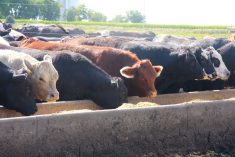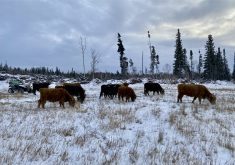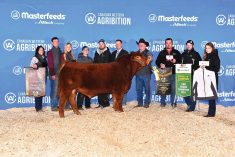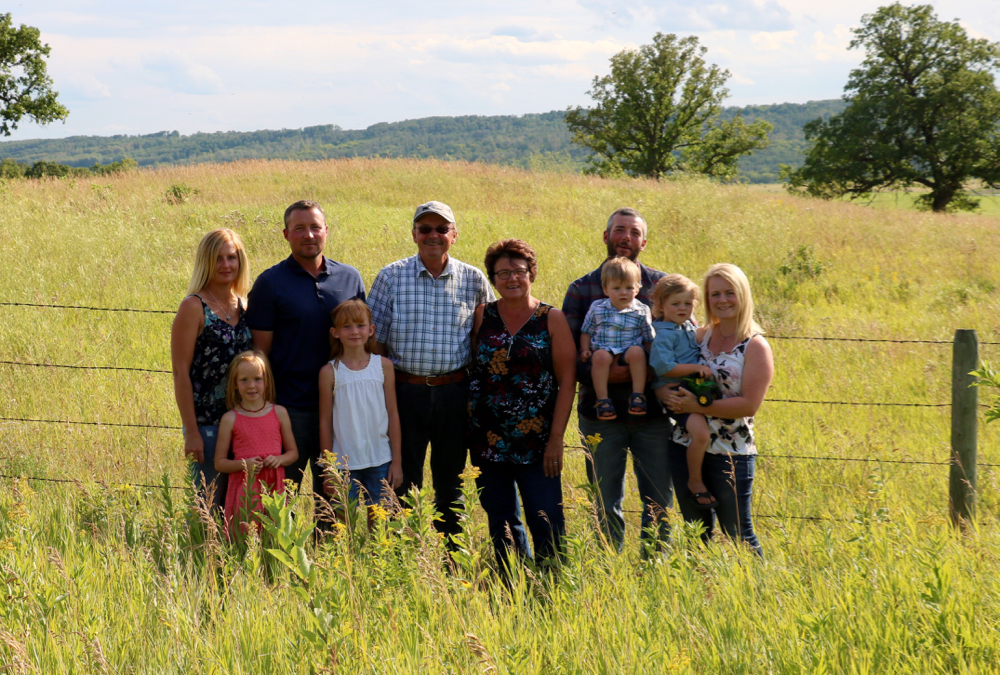Tessa and Colin Verbeek will forever look back on 2015 as a landmark year. They married, established a new yardsite with a home and barn where they hosted their first annual prospect-calf open-house sale, she accepted a position as general manager of the Canadian Limousin Association, and he took the plunge into farming full time with his parents on the family’s fourth-generation mixed grain and Limousin operation, Hillview Farms, near Morinville, Alta.
It’s really only the beginning of the story. They started penning for themselves in their high-school years after meeting during a 4-H camp at Olds College, where both later completed the two-year agricultural management course, majoring in marketing.
Read Also

Body condition, nutrition and vaccination for brood cows
One of the remarkable events of the past century related to ranching has been the genetic evolution of brood cows….
The next chapters are bound to blur together as they work toward assuming full management and ownership of the farm, while Colin’s parents, Raymond and Corine, look ahead to their eventual retirement.
“Some people like to ease into farming, but we decided that if we ever did want to expand the land or herd, it could happen faster with me being in full time,” says Colin.
He always thought he’d like to farm, but never felt obligated to take over the family farm. The time seemed right to jump in with a running start while cattle prices were on the upswing and with his parents at a point where they weren’t too keen to expand on their own, yet not ready to move on. Their commitment to farm with his parents is only the first step in the long process of succession planning, he adds.
They also have the full support of Tessa’s parents, Joan Nybo and Larry Frischke, at Sundre, Alta., where she grew up with animals being a big part of family life. They have a small commercial herd, her mom works at a veterinary clinic and her dad is a veterinarian who practiced for 20 years from his clinic in Innisfail and now regularly does locums for local veterinary clinics.
Their plan for the immediate future calls for continuing as a mixed operation.
“The Limousin herd, with 150 purebred cows, has been a lifetime pursuit for Colin’s parents and we will continue with that,” Tessa says. “As the transition occurs with us taking over, we hope to maintain that number and work on improvements, such as shortening the calving interval. We will continue to work closely with my parents as well, and eventually bring the commercial herd over.”
The commercial herd includes several of Tessa’s cows that are the foundation of the show-cattle business she started a couple of years ago and she and Colin now operate together as Crossing Creek Cattle. The name is a reminder of challenges overcome while establishing their yard on the far side of a creek that borders the full length of their property.
Select crossbred cows are bred to popular club-calf sires to produce sound and showy calves for purchase by youth who participate in 4-H and jackpot shows. Their goal is to raise quality calves that are successful in the show ring, safe and fun for youth to work with, in hopes of passing on their own love of showing cattle to an even younger generation.
It’s a venture that complements their cattle-clinic business, which in recent years has been taking them on the road at least a dozen weekends a year to coach kids in grooming and showmanship, not to mention nearly as many trips to help judge 4-H and youth events. Tessa started offering cattle clinics for 4-H clubs five years ago and interest has grown to include requests from other youth organizations and bookings at community events, such as Northlands Farm and Ranch Show, FarmFair International, Camrose Bull Congress and the Calgary Stampede. One unique setting was Australia, where they led a clinic for agriculture students from local high schools when a scholarship opportunity came her way to work for a month at Manali Limousin and Lim-Flex.
Their clinics cover any and all aspects of showing cattle for beginners on up, from choosing a show calf, calf care at home and halter breaking to clipping, grooming, fitting for shows, showmanship and judging, depending on each group’s needs.

They built their ideal calving barn as a multi-use facility to accommodate many business needs. The main section is roomy enough to set up eight pens with portable panels for calving season and host clinics and sales at other times of the year. It includes a two-head wash rack, front office area and washroom. A lean-to off one side is slated for their processing area, which will come in time as the budget allows. The other side is a covered drive-through for tractors and storage.
With help from handy relatives on weekends, they had the building far enough along by late September to host their first prospect-calf open house and sale with phone-in bidding, along with free cattle clinics over the two days.
Most of the calving will happen at the home place this year because the design for the corrals and water system is still in the works. They hope to use as much steel as possible for the job so that the corrals won’t have to be replaced during their lifetime in farming.
Summer will bring another round of fencing, adding cross-fences within the perimeter fence they put up around some hayland near their yardsite last fall. Land is at a premium in their area being so close to Edmonton and first class for growing grain, so most of the cattle are trucked elsewhere to rented pasture for summer grazing.
The people factor
Whether it is the lasting connections made through their years of involvement in 4-H and at college, or those made at industry conferences and events in recent years, it’s all about people. They count participating in the Cattlemen’s Young Leaders program in 2014 among their best experiences.
Tessa’s mentor was Jamie-Rae Pittman at Kyle, Sask., who operates a marketing company focused on serving agriculture. They found themselves in similar situations having moved their lives and businesses to other areas to farm and ranch with their husbands. Tessa was interested in how Jamie-Rae managed the transition, as well as learning all she could about how to successfully market purebred cattle, right down to the finer details of photographing cattle and catalogue design.
Colin was paired with Dyce Bolduc of Cudlobe Angus, a reputable purebred operation near Stavely, Alta., who mentored him on aspects of herd management, genetics and feeding for profit.
“The cattle industry is an interesting group,” Colin says. “When we talk with people or tour their places, they are always excited to share things about what works for them. I think I’ve learned the most just from talking with people — and from our parents. We can take it all in and consider if it fits in our budget.
“It’s quite amazing the people out there who are willing to help if you have a plan for the future, passion, motivation and end goals and they can see it. You need that kind of support because it would be impossible to get started in farming today without it and family backing.”

Start with a plan
They started with the basic plan that Tessa had worked up for a college project, and it took another year to flush out all of the details specific to their operation.
“It really makes you stop and think about where you want to be, how you will get there and what’s needed to get there,” Colin says.
“We have deviated very slightly from our original business plan, primarily due to finances, available time, succession plans, and the current cattle market,” says Tessa. “That is OK. A business plan is something to keep you on the right trajectory, but if you need to refocus for one reason or another, there is nothing wrong with that.
“In hindsight, I wish we would have shared our business plan with our parents in greater detail. Both our families are aware of our goals and intentions, but I think, especially in a succession scenario where an individual or couple are going to be taking over a farm operation from parents, it would be very worthwhile to encourage the parents to read your business plan and talk about it together. Just because your family knows you want to keep farming does not mean they know the full extent of your own plans and dreams for the operation and your future.”
“We are fortunate because right from a young age in high school, we were together and both of us had a clear idea of what we wanted to do. We had a goal and plan and went for it,” Tessa sums up.




